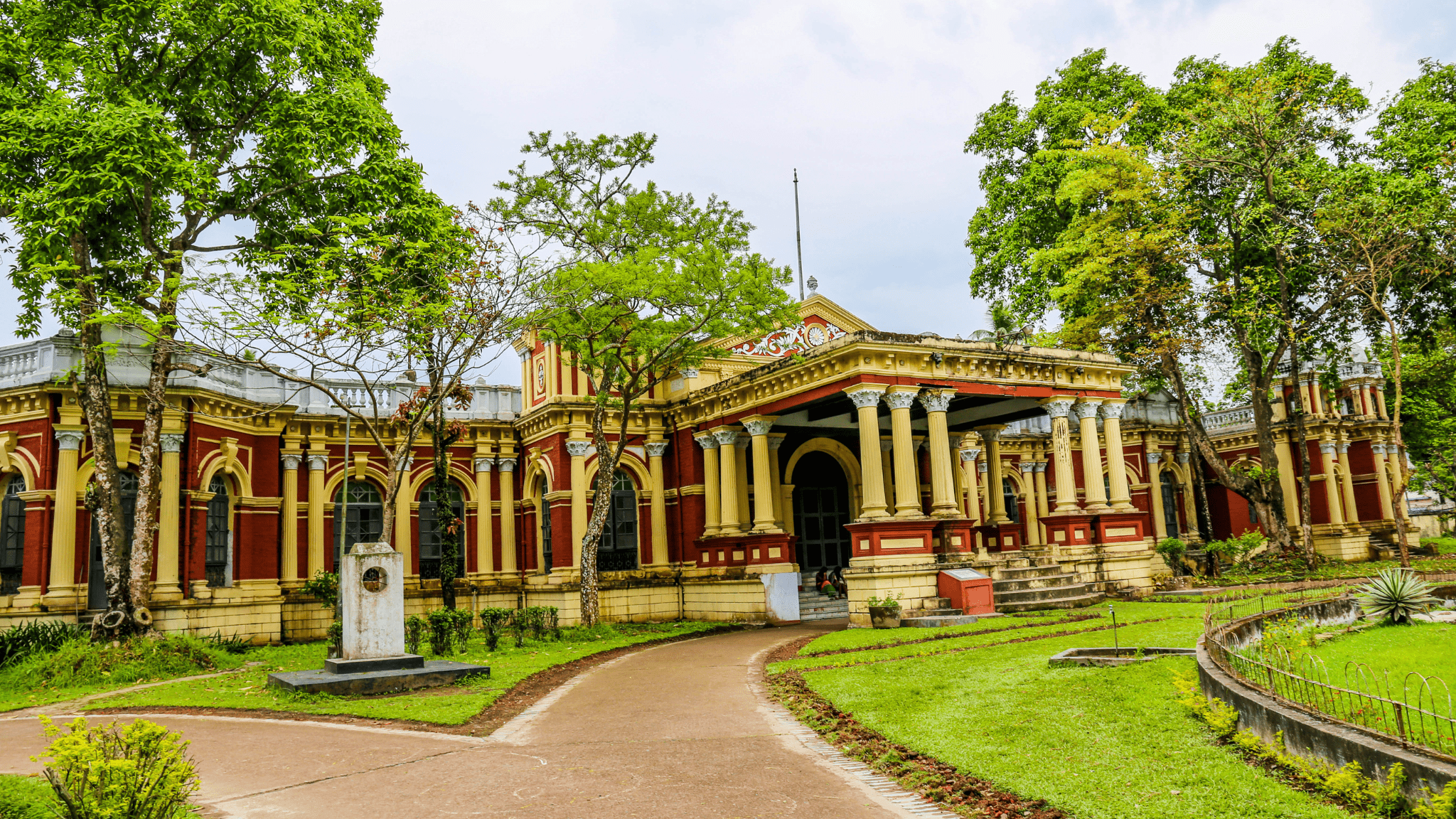Shoshi Lodge
Shoshi Lodge, the exquisite residence mansion of Moharaja Shashikanta Acharya Chowdhury, is one of Mymensingh’s most beautiful monuments. This palace, located in the administrative region, has certain unique architectural characteristics that depict the Zamindari lifestyle of the period. The dramatic tale of Zaminder’s life, as well as the grandeur of their existence, were commemorated via the design manifestations of various places in this structure, which were influenced mainly by the European-style architecture of the time. Most people stop to admire the architecture of this historically significant structure. The palace was originally a two-story edifice erected in 1877 by Maharaja Suryakanta Acharya Chowdhury.

Origin of Shoshi Lodge
Raghunandan Acharya Chowdhury, the third descendant of Shrikrishna Acharya Chowdhury, the founder of Muktagacha Zamindari, was childless. But according to the organizational structure of patriarchal society, a son capable of preserving property is greatly needed. So he decided to adopt a son. Gaurikant Acharya Chowdhury was adopted by Raghunandan. Before his death, he handed over the zamindari to his adopted son.
Fate, it seemed, had a fickle hand when it came to Zamindar Gaurikant Acharya Chowdhury. He, too, departed this world without leaving an heir to carry forward his legacy.
After his passing, his wife Bimala Devi found herself a widow with no child to call her own. In her quest to preserve the family’s lineage, she decided to adopt a son named Kashikant. However, destiny had another twist in store. An ominous shadow seemed to linger over Kashikant. Stricken by a prolonged illness, he, too, left this world without the laughter of a child to inherit the legacy.
Undeterred by these somber events, Kashikant’s widowed wife, Lakshmi Devi Acharya Choudhurani, chose to follow in the footsteps of her predecessors. She adopted a young boy to continue the lineage. This time, it was a child named Purnachandra Majumdar.
In a solemn ceremony conducted in the presence of Kulguru and Goddess Lakshmi Devi, the child was granted a new name – Suryakant Acharya Chowdhury. It was a name that would carry the hopes and dreams of the family into the future.
For about 41 years, Suryakant dedicated his life to managing the zamindari, which was a significant responsibility in those days. However, he didn’t stop there. He was a man with a vision, one that extended beyond mere governance.
He had an eye for aesthetics, and this became evident as he set out to create beautiful structures in the charming town of Mymensingh. At the cusp of the 19th century, Suryakanta embarked on a remarkable project. With unwavering determination, he constructed an extraordinary two-story building that stood tall on a vast expanse of nine acres right in the heart of Mymensingh city.
This architectural marvel was named “Shashi Lodge” in honor of Suryakant’s adopted son, Shashikant Acharya Chowdhury. It was a symbol of their bond, a testament to love transcending bloodlines. The grandeur of the building reflected the dreams and aspirations of a man who wished to leave a lasting legacy.
But life has a way of testing even the best-laid plans. In 1897, tragedy struck when the Great Indian Earthquake shook the very foundations of this famous building. Suryakant was heartbroken, for he had poured his soul into its creation.
Yet, the story didn’t end there. In 1905, the next Zamindar, Shashikant Acharya Chowdhury, took it upon himself to rebuild Shashi Lodge on the same hallowed ground. He was determined to uphold the family’s legacy and carry forward the dream of Suryakant. In 1911, he completed additional renovations, further enhancing the Lodge’s beauty. It became a resplendent haven, a testament to the unwavering spirit of the new landlord.
Shoshi Lodge, with its rich history and the love and dedication of the Acharya Chowdhury family, emerged as a beautiful and wonderful place for all to admire and cherish. It stood as a symbol of resilience and the enduring power of a dream that refused to be shattered.

Shoshi Lodge is an immortal achievement of the richest zamindar of East Bengal in British India. Humayun Ahmed’s timeless TV drama Ayomay was shot in this Shashi Lodge. This palace is also known as Mymensingh Rajbari. This building named Crystal Palace was also known as Rang Mahal. It has a lot of Byzantine architectural style. There is a beautiful garden in front of the main building. In the center of the garden is a white stone fountain and a statue of the Greek Goddess Venus. Its main gate has 16 domes. Every room has hanging chandeliers. There are 18 spacious rooms. There are also two-storied baths, ponds, marble stone ghats.

The grand structure boasts a generous expanse, covering no less than 50,000 square feet. Every inch of the building’s floors is adorned with the timeless elegance of marble stone. An intricately carved iron staircase gracefully winds its way to the roof, adding an air of sophistication.
Inside, a continuous waterline flows through the building, a testament to its thoughtful design.
Adjacent to the palace, a picturesque pond graces the landscape. Nestled beside it is a charming two-story building, ideal for relaxation. The staircase is a work of art in itself, with two toilets thoughtfully placed on each floor. Though the commodes have been removed, the pipes and water lines remain intact.

Two round marble-clad pillars once served as seating within the pond, providing a tranquil spot to enjoy the surroundings. For those needing a change of attire, a clothing changing room stands close by. The lodge is encircled by stately trees, silent witnesses to the passage of time. The imposing boundary wall, a century-old sentinel, still stands strong.
It’s a historical tidbit that the “Monda of Muktagacha” was a royal indulgence, exclusively crafted for the Maharaja. Commoners were forbidden from savoring the delicacy, reserving it solely for the kings’ palates. Any surplus Mondas found their way to Shankha and Sambhu, the palace elephants. Remarkably, fragments of their skeletons have found a new home in the Momenshahi Museum, nestled close to the iconic Shashi Lodge.


Since 1952, Shashi Lodge has been used as a Women’s Teachers Training College. The main part of the building was used as the office and office of the principal of the college. The Directorate of Archeology of the Government of Bangladesh took Shashi Lodge to set up a museum on April 4, 2015.

